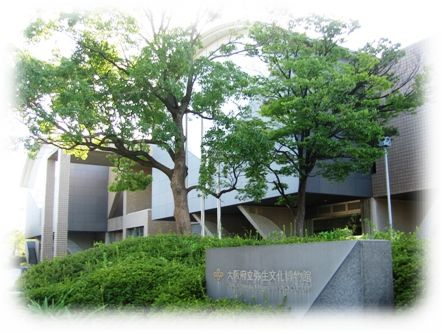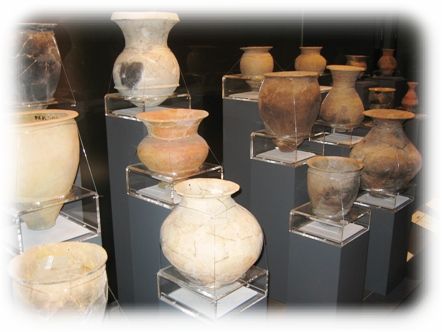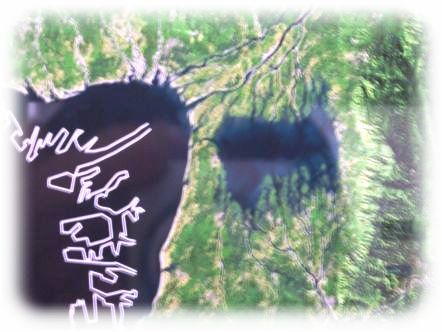Large Settlement of Yayoi Period - Osaka Prefectural Museum of Yajoi Culture [Outing]
“After the conveyance of technology such as the rice growing from Eurasia continent, people in Japanese islands began to cultivate the rice, changed the structure of society and made own life better. In due course, people broke out the war over the rice, the iron, the land and the water. 'Villages' are united, and formed into 'Nations', and then it gave birth to 'King'. In the course of time, the serious disturbance broke out in Japan. Cartels publically elected the queen, 'Himiko'. Then the disturbance was quelled.” ... This museum explains the historical flow and the people’s life scene from the Jomon period, - the pre-ceramic period to about B.C. third century -, to the Yayoi period, - about 200 B.C. to A.D. 200 - , with exhibitions.




Web Site of Osaka Prefectural Museum of Yayoi Culture (Only Japanese)
http://www.kanku-city.or.jp/yayoi/index.html
MAP
http://www.mapfan.com/en/en_m.cgi?MAP=E135.25.47.7N34.29.55.5&ZM=5
How To Get There
Walk five minutes from Shinoda-yama Station on JR Hanwa Lines
Otherwise, walk twenty minutes from Matsuno-hama Station on Nankai Lines
Public Explanation on Archaeological Site - Makimuku, Sakurai in Nara
http://ease-loving.blog.so-net.ne.jp/2009-04-04#more
<弥生時代の大集落 - 大阪府立弥生文化博物館>
「大陸方面から米つくりなどの技術が伝わり稲作が始まったことで社会の仕組みが変わり、人々の暮らしがよくなました。そのうち米・鉄・土地・水をめぐり戦いがおこりました。「ムラ」がまとまり「クニ」が成立し「王」が誕生しました。やがて日本に大乱がおこり、女王「卑弥呼」が共立され、争いがおさまりした。」... ここでは縄文から弥生時代への流れや生活の様子が展示物とともに語られます。
大阪府立弥生文化博物館(日本語のみ)
http://www.kanku-city.or.jp/yayoi/index.html
アクセス
南海本線 松ノ浜 徒歩20分
JR阪和線 信太山 徒歩5分
発掘遺跡説明会 - 纏向遺跡 (奈良県桜井市)
http://ease-loving.blog.so-net.ne.jp/2009-04-04#more
想像力
http://ease-loving.blog.so-net.ne.jp/2008-08-04
斑鳩の空 – 変化への視座
http://ease-loving.blog.so-net.ne.jp/2008-11-15#more
(H)

[Fig.1]
It was very fine day. Here is the main gate of Osaka Prefectural Museum of Yajoi Culture. Today I went for a change. It was very pleasure for me to learn the historical flow with exhibitions, from the Jomon period to the Yayoi period. I have been fascinated in the ancient history since the time I dug up “Ancient Shell Heap” in childhood.

[Fig. 2]
Visitors can know the life scene of those days by the unearthed living ware. By the way, recently, the Makimuku ancient site, - maybe in three century - , attracted the attention of people, because “Himiko” might really be being just around there. Actually, there is an ancient tomb that might be Himiko’s. From about third century, the ancient burial mound, - like a 'keyhole-shaped or womb-shaped' tumulus - , began to spread all over Japan. It seems various peoples are explaining their theories about the relationship between “Kingdom of Yamatai” that Himiko was the queen, and “Dominant Yamato Polity”.

[Fig.3]
This is the Osaka’s satellite photograph in the Yayoi period. Though this would be a reproduction photograph, it is well-designed. We can see there were big lakes or marshes in Higashi Osaka - Eastern Osaka. Before that, it seems it was an arm of the sea which connects to the Osaka Bay in the former Jomon period. There was a peninsula - now in uehonmachi-roku-chome on the tableland. After "Reformation of Taika" in A.D. 645, the capital of Japan was placed, called as “Naniwa Kyu”, on this peninsula - now in Tanimachi-yon-chome. It seems there was a water way that connects between the bay and big lakes - now under or around Osaka Castle. Now, OSAKA is the moated city. However it seems it was made in the by far descendant period. Osaka, - including Sakai - , has developed the moat by using the water facility, not in recent days, but since early times. It might be a geographical factor in it.

[Fig.4]
This is the restored large building in Ikegami-Sone ancient site. A part of large settlement, a moated settlement in Yayoi period, was restored. People was living here from the third to the first century B.C. It is good for you to see this site and the adjacent museum at the same time. You will think of what kind of life here was. I recommend you to visit here once, if you are interested in.
Web Site of Osaka Prefectural Museum of Yayoi Culture (Only Japanese)
http://www.kanku-city.or.jp/yayoi/index.html
MAP
http://www.mapfan.com/en/en_m.cgi?MAP=E135.25.47.7N34.29.55.5&ZM=5
How To Get There
Walk five minutes from Shinoda-yama Station on JR Hanwa Lines
Otherwise, walk twenty minutes from Matsuno-hama Station on Nankai Lines
Public Explanation on Archaeological Site - Makimuku, Sakurai in Nara
http://ease-loving.blog.so-net.ne.jp/2009-04-04#more
<弥生時代の大集落 - 大阪府立弥生文化博物館>
「大陸方面から米つくりなどの技術が伝わり稲作が始まったことで社会の仕組みが変わり、人々の暮らしがよくなました。そのうち米・鉄・土地・水をめぐり戦いがおこりました。「ムラ」がまとまり「クニ」が成立し「王」が誕生しました。やがて日本に大乱がおこり、女王「卑弥呼」が共立され、争いがおさまりした。」... ここでは縄文から弥生時代への流れや生活の様子が展示物とともに語られます。
[Fig.1]
この日はお天気が非常に良かったです。こちらが、大阪府立弥生文化博物館の正面玄関。今日は気分転換です。縄文から弥生時代への歴史が展示品とともに学べて楽しかったです。子供のころ「貝塚」の発掘をして以来、古代史に関心をもちました。
[Fig.2]
出土した生活用品で当時の様子を知ることができます。ところで、昨今、奈良県の纏向遺跡(3世紀)あたりに「卑弥呼」がいたのではと注目があつまりました。実際、卑弥呼の墓では?というものもあります。日本全国に前方後円墳が広まるのは3世紀ごろから。卑弥呼が女王だった邪馬壹国からヤマト王権との関係はいろいろな人が説を立てているようです。
[Fig.3]
弥生時代の大阪の衛星写真です。再現画像ですが良くできています。東大阪には大きな湖沼が見られます。もっと前、縄文時代は海とつながった「湾」だったようです。上六の台地は半島になっていました。大化の改新の後、645年に「難波宮」がこの半島に建設されます。(現在の谷六あたり)。大阪城あたりは湖沼と海を結ぶ水路でしょうか。今の堀を巡らせた大阪に町が建設されるのはかなり時代が下ってからのようです。しかし、大阪(や堺)が水利を利用して堀を巡らしたのは今に限らず昔から地理的な要因があるかもしれません。
[Fig.4]
池上曽根遺跡の大型建物(復元)。弥生時代の大集落(環濠集落)の一部を復元したものです。ここで人が生活をしていたのは紀元前3~1世紀ぐらい。この遺跡と近隣の「弥生博物館」と合わせて見学すると、どんな暮らしがあったのか色々と偲ばれると思います。興味のある方は是非一度。おすすめです。
大阪府立弥生文化博物館(日本語のみ)
http://www.kanku-city.or.jp/yayoi/index.html
アクセス
南海本線 松ノ浜 徒歩20分
JR阪和線 信太山 徒歩5分
発掘遺跡説明会 - 纏向遺跡 (奈良県桜井市)
http://ease-loving.blog.so-net.ne.jp/2009-04-04#more
想像力
http://ease-loving.blog.so-net.ne.jp/2008-08-04
斑鳩の空 – 変化への視座
http://ease-loving.blog.so-net.ne.jp/2008-11-15#more
(H)




和泉市にあるんですかぁ
今度近くに行ったら、是非覗いてみたい^^
by Ranger (2009-09-25 12:47)
是非、よって行ってください。「海を渡った弥生人」の展示あたりは関西人だけでなくても結構、面白いと思います。
by Hide (2009-09-26 23:30)